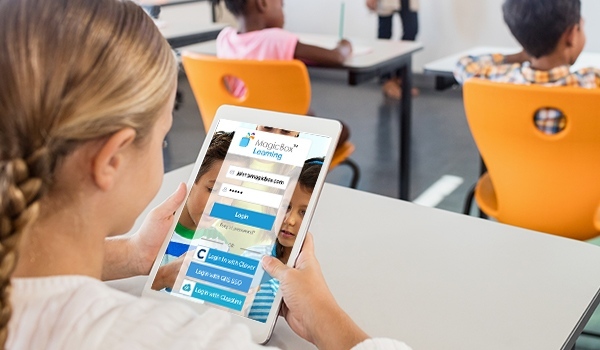
The proliferation of technology in classrooms has been one of the vital themes of the COVID-19 pandemic. Around 74% of school districts used more than 26 types of EdTech platforms and products by the end of 2020. Since these platforms do not link to each other, it results in a complicated ecosystem for teachers and districts to navigate. In this new era of remote learning, it is clear that educators need actionable data to assess the impact of different tools on student learning outcomes. Assessments become difficult when usability, format, comprehensiveness, and accessibility of this data are not adequate. Critical student data exists inside silos across disparate platforms and applications that don’t “talk” to each other. There is thus an increased focus on data interoperability standards in EdTech platforms.
MagicBox and GG4L
MagicBox™ digital learning platform, is built upon the premise of data interoperability to enable seamless learning experiences for users. It readily integrates with a school’s existing ecosystem and learning management systems. In partnership with GG4L, it enables educational institutions and educational service providers to manage all their rostering and student information from a single dashboard rather than resort to multiple apps.
Vital Issues in Education Revealed by the Pandemic
Data sharing is not the only aspect of interoperability. Different information systems, applications, and devices need to connect in a coordinated manner inside and across institutional boundaries to enable the cooperative exchange of data among stakeholders. It is essential to address some glaring issues presented by the pandemic, such as student absenteeism.
Research indicates that attendance is essential for academic success. Chronic absenteeism has been a problem for US school districts for years now. But the pandemic and the resulting socio-economic impact have elevated these issues. Different surveys conducted in 2020 have highlighted that remote learning has exacerbated inequity in education, driven by technology and internet access gaps.
Attendance data is thus an important aspect now, and various districts from California to Connecticut are rewriting legislation related to attendance, tying it with students’ interactions with learning materials.
This calls for seamless interoperability so that districts can identify at-risk students and intervene at the right time. For instance, when students log in to watch videos, submit assignments, and more, participation data gets stored on the digital learning platform, which can populate attendance fields in the student information system (SIS).
How it Benefits EdTech Platforms and District Leaders
District decision-makers have established that “interoperability” is a new differentiator. In day-to-day classroom operations, purchasing decisions by schools and districts, and federal reporting requirements such as ESSA, the data-driven decision is becoming the new norm. Data interoperability was a vital concern in procurement decisions for 72% of school districts in 2018. So, vendors who deliver on these lines have greater chances of getting contracts from reputed institutions. The question is, why?
Without data interoperability, we cannot realize the full potential of an EdTech tool. We establish two scenarios.
Instructional Impact for Teachers
For a teacher, the power of interoperability can help create a huge impact. Rather than learning how to operate disparate systems, they can focus on their actual work to drive positive outcomes for students. Interoperable automated systems release teachers from administrative burdens of grading assignments, printing materials, entering student details, and other such work to address students’ social and emotional needs and personalize lessons for them. This enables more professional learning at scale, a positive aspect for teachers who resisted technology use in the past. Also, with blended instruction, teachers find many lesson inspirations from a variety of sources.
Enabling Personalized Learning for Students
A single sign-on (SSO) platform can provide students access to different resources without needing to sign in repeatedly to use various apps. As they access new learning materials and submit assignments, the system automatically records their performance and preferences. Based on that, they can receive recommendations for other resources aligned to their academic standards and learning needs. Students and teachers will know what concepts the students have mastered and what are the improvement areas. All performance data will be safely and confidentially visible on a dashboard for teachers to analyze.
There are different types of interoperability standards that MagicBox™ is leveraging to make data meaningful and accessible.
- Question and Test Interoperability (QTI): Closely related to the Accessible Portable Item Protocol (APIP), QTI allows the exchange of test content and results between learning platforms, authoring tools, analytics engines, and more.
- Learning Tools Interoperability (LTI): This is a standard through which multiple tools, apps, and platforms can blend to create seamless learning experiences. For instance, imagine an AR biology app where students can learn about tissue layers bypassing their phones over an old class skeleton. Without data interoperability, this fun lab activity would have meant extra work for the teacher.
- Application Programming Interface (API): Protocols like OneRoster are allowing schools to exchange roster information, course materials, and student grades securely between systems, such as a student information system (SIS) and a learning management system (LMS).
Future of Data Interoperability Post-Covid
Uncertainty still looms large across the world, and this includes the presence of children in physical classrooms. Educators, parents, and students have much to gain from data interoperability in such circumstances. The failure to embed such protocols could threaten to widen the achievement gap among K-12 students. Also, while schools and districts continue to advocate for the best solutions in interoperable standards, educators cannot be expected to become data scientists to leverage these platforms.
Forward-thinking platforms like MagicBox™ focus on the right balance between scalability and interoperability so that educators can use the platform quickly to its full potential. Global Grid for Learning members can gain access to MagicBox through School Passport.

